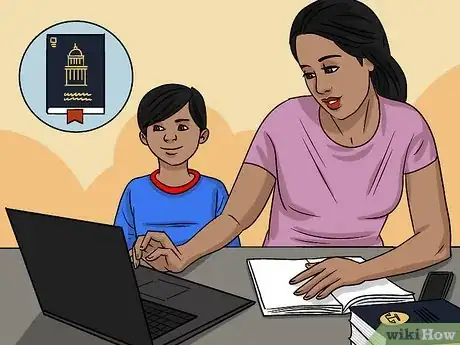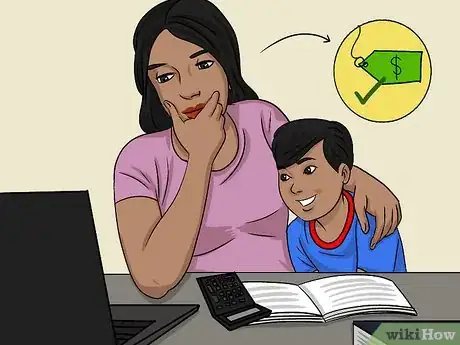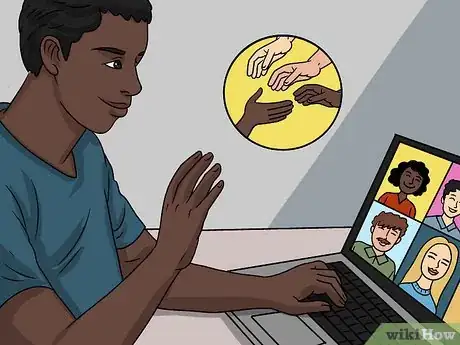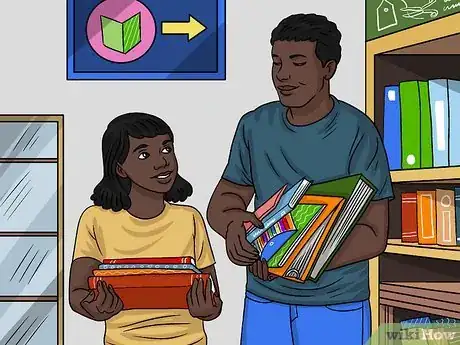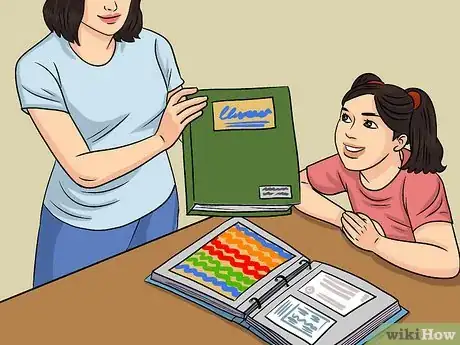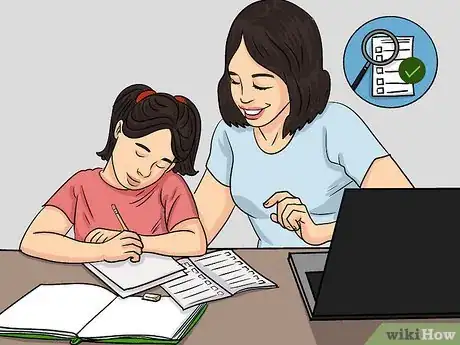This article was co-authored by Alexander Ruiz, M.Ed.. Alexander Ruiz is an Educational Consultant and the Educational Director of Link Educational Institute, a tutoring business based in Claremont, California that provides customizable educational plans, subject and test prep tutoring, and college application consulting. With over a decade and a half of experience in the education industry, Alexander coaches students to increase their self-awareness and emotional intelligence while achieving skills and the goal of achieving skills and higher education. He holds a BA in Psychology from Florida International University and an MA in Education from Georgia Southern University.
There are 8 references cited in this article, which can be found at the bottom of the page.
This article has been viewed 500,343 times.
Homeschooling is a brilliant way to stay connected with your son or daughter and it can have its benefits. This article will show you how to homeschool your children while keeping them social and happy to learn. For this, your child or children will need a certain amount of self motivation and it is your job to make sure they have it. You do not have to follow the curriculum and can change the education to suit your needs and likes.
Steps
Getting Over the Initial Hurdles
-
1Establish your home education legally. In the US, each state has different laws and regulations regarding home-school. Generally speaking, New England has the most stringent requirements.[1] Before you jump in, research your state's laws and give them the required notice, in addition to making a checklist of future deadlines for yourself (if applicable).
- Since home educators have a personal investment in ensuring they understand the homeschooling laws correctly, local support groups are often the best resource to steer you to the most accurate legal information in your area.
- Be advised that the legal requirements for home educators vary by country, state, and even sometimes by school district, so a bit of research will be required.
- HSLDA and A to Z Home’s Cool provide useful guides to what it means to home-educate legally (see external links below).
- You may be required to keep a portfolio of your children's work. It is very important to do this from day one if required by your state.
-
2Make sure it's financially doable. Depending on your take of "homeschooling," the amount of money you'll be investing in your child can vary greatly. The job can be done with $300 or it can be done with $2,500. It all depends on what supplies you'll be using and activities you plan on doing.
- Activities, unfortunately, aren't always free. In order to get the best of the world (and learn more while they're at it), you could supplement their lessons with trips to planetariums, art exhibits, lectures, showcases, nature preserves and the like -- but these things can cost money.
- For the record, those two figures mentioned above represent the ends of the average home-schooling spectrum.[2]
Advertisement - Activities, unfortunately, aren't always free. In order to get the best of the world (and learn more while they're at it), you could supplement their lessons with trips to planetariums, art exhibits, lectures, showcases, nature preserves and the like -- but these things can cost money.
-
3Enroll your child in community activities. Get them involved in some kind of sport or other activity that they like; your child will need social interaction and time spent away from home. Don't force them to do anything, but don't let them give up too easily, either. These activities get children to socialize and also teach important life skills such as making friends and keeping commitments.
- Homeschooling your child will not "ruin" them. As long as you make sure their emotional, social, mental, and physical needs are met, they'll be successful adults in the future. Ask them what activities they'd like to do that span their interests and get them started on the right path.
- Research says home-schoolers are just as involved as their publicly-schooled peers. They help the community and can make just as many social connections.[3]
- Homeschooling your child will not "ruin" them. As long as you make sure their emotional, social, mental, and physical needs are met, they'll be successful adults in the future. Ask them what activities they'd like to do that span their interests and get them started on the right path.
-
4Inform extended family. Others in your family who care about you and your children can be helpful and give great support to your home education efforts -- or they can be heartbreaking critics. Plan how you will tell them what you are planning to do, listen to their responses, and answer questions and concerns they may have. Help them understand that you are prepared and determined, and don't let any negative attitudes get you down. They care, and over time as your children show success in their education at home, they very well may come around and be your greatest supporters.
- In fact, why can't they aid in helping your children learn? Surely they have areas of expertise that you don't. Let them know you want them to be a part of your child's life, too -- how could they possibly turn it down?
Your Teaching Approach
-
1Be confident in your teaching abilities. Realize that you care about your child's future more than anyone else does. Therefore, you are uniquely qualified for the role of homeschooling parent. Homeschooling is a big responsibility, but if you mold it to your family lifestyle it can work well -- regardless of your education or expertise. It does not require you to give up the rest of your interests; you can still have a life outside of homeschool.
- While it's pretty easy to get a child through grade school, you may find it's harder to be confident in yourself when it comes to putting them through high school. But it is doable and people have done it. Just know that you'll be learning, too!
-
2Learn about different home education methods. Different styles abound and can be learned from and used as resources. The schools of thought vary widely when it comes to this topic, so it's best to sit down and find where you fall on the spectrum of belief yourself.
- Unschooling: This is an anarchic approach where the student is self-directed. It's based on the idea that a student is likely to learn quickly and easily when they study things they are interested in.
- Diane Lockman offers an approach geared towards reading, thinking, and communicating, with a heavy Christian emphasis. She even offers online high school courses.
- Unit studies -- where each unit is dedicated to a different topic. You can often find units (and other varied curricula) online.
- Charlotte Mason’s methodology is a little less conventional and focuses on "atmosphere, discipline, and life.[4]
- Montessori or Waldorf methods, where the child is more independent and "discovers" rather than is told.[5]
- An eclectic blend of different styles
- A complete online curriculum package like Global Student Network
- A private online school like International Virtual Learning Academy
-
3Determine your own style of home education. Examine your own intentions and motivations. Why do you want to home educate? What do you consider a ‘good’ education? What do you believe about children, teaching, and learning? How do your children seem to learn best? These questions can help you determine what approach to take and help you create a learning environment that will be best for your family and your children.
- Consider, too, that an approach that works for one child may not be best for another.[6] In addition, what you may prefer may not be best for them. Talk to your child about their expectations before you go about outlining the year.
-
4Plan your curriculum. The enormous volume of material and methods that are available can be overwhelming for a new homeschooling parent. It's easy to forget how useful it all is! Identifying your approach will be the first step in narrowing things down. There are many resources to help you navigate through the maze of ideas. Research, read, and plan what you want to teach and how.
- Libraries and bookstores have books on home education methods, experiences, and proven curricula.
- The internet offers a never-ending source of information as well: basic information on various subjects, online purchase of curricula and supplies, articles about methodologies, support groups, and public school curricula. It even has free lessons on most subjects from teachers, other home educators, and even television stations.
- Authentic classical education involves teaching reading, thinking, and speaking to substantial mastery. However, Unschoolers, while agreeing with the classical education system, usually have a wide variety of resources for their children to experience, but no formal curriculum. It's all up to you.
- You'll want to touch on art, the sciences (Biology, Physics, Chemistry), languages, music, mathematics, history, and geography, for starters.
-
5Look for local support. You can find local groups that meet regularly, organizations that put on periodic seminars or conventions, or even online groups that swap ideas and resources. Many groups set up co-op classes--taught by other parents--in a variety of subjects. If you start to feel overwhelmed, frustrated, or all alone in your family's educational pursuits, a support group can offer advice or just a reassuring acknowledgment from other parents that you are not alone.
- They are also an invaluable resource for tips on how to comply with the home education laws in your area. If you have any questions at all, a local support group should be your place to turn. And your child could meet other homeschoolers!
-
6Gather supplies. Home education supplies vary greatly according to teaching method. You can order textbooks, boxed curricula, and learning tools online or at home-educating curriculum and supply sales. For cheaper alternatives, many home educators use libraries, used book stores, curriculum swaps, thrift stores, and garage sales.
- Back-to-school-sales at local discount stores or office supply stores are the perfect place to get some of the basic supplies like pens, notebooks and glue. Stock up in August and you'll last throughout the year.
As You Go
-
1Plan your day. If you choose to have a more formal home education environment, you can prepare by gathering your lesson plans, materials, and textbooks together -- or even by setting up a room in your house for studies and activities. However you choose to home educate, it can only be helped by planning and preparing as much as you can before you start.
- A different approach might mean your preparation involves setting up field trips for the rest of the year in every subject, placing learning objects around your home, or simply getting yourself into a mindset of using every day as a learning opportunity with no set plans or textbooks.
-
2Look for hands-on activities.[7] Everyone benefits from seeing things firsthand.[8] Some activities that can be educational as well as easy to do are: gardening, cooking, sewing, composting, science projects, hiking, fixing the house, caring for pets, and taking apart broken appliances (just make sure there are no lasers or dangerous electronic components still active). Your children will learn different things depending on their ages, but everyone will come away better educated.
- Make sure your activities are fact-filled and concept-checked. Planting flowers can be a learning activity -- or it can be an activity where a child got to play in the dirt. If you do do activities around the house, accompany it with a reading or other supplementary tool.
- Some kids naturally learn better through hands-on activities—they're known as "kinesthetic learners."[9]
-
3Keep a portfolio of each child's work. Thick, three-ringed binders with tab separators for each student are an excellent way to keep track of schoolwork, along with whatever may be required from a legal standpoint. Label each tab with whatever subjects you are studying. After your child has completed a page, punch holes (using a three-ring hole punch) and snap the page into the proper section of their book. Remember to date each page or it will be a big jigsaw puzzle to figure out later.
- This is especially useful if your child is thinking of going to college, as some schools require portfolios of work from homeschool students. And you could always use the materials for reference later for your next child or for your friends or relatives.
-
4Go with your gut feelings. Trust your knowledge and instincts regarding your own children. You are not only the one ultimately responsible for guiding your children's education, but you are often the one person best able to recognize what they do or do not need. Turn to evaluations and insights from others to help guide you, but trust your own instincts about what your children need to learn and do in their educational progress.
- Questioning yourself is normal. You may feel like you do it all the time, especially when you first start. This is when your support group comes in handy and you should utilize the tools (like the Internet) you have at your disposal. Odds are you are just as qualified as the next parent who's doing it and have nothing to worry about.
-
5Periodically evaluate your progress. Progress evaluation happens naturally through the one-on-one process of home educating, although in some areas the law requires periodic formal testing or evaluation of home educators. Personal evaluation, however, should not only consider how your child is doing academically but also how the process is working for everyone in the family.
- If the teaching methods are a poor match with your child’s learning style, if the curriculum is too structured or not structured enough, or if the process of home educating seems to be making things worse rather than better, then it’s time for a change. Fortunately, change is something you can do fairly quickly with just a little research.
- If you feel uncomfortable with your level of knowledge on the subject, there are standardized progress tests (such as FCAT) that your child can take and then have the scores mailed to you, and you can find many other tests to order or take online.
Keeping Your Children in Mind
-
1Prepare your younger children. Explain to them what is going to happen in the months to come, including how daily life will be structured for them and the rest of the family. Explain to older children that though they may be leaving their school, it doesn't mean they are leaving their education or their friends.
- Ask them what they would be interested in studying.[10] For example, if they love stargazing, get a telescope and study astronomy. Be sure to get them excited. Home education should be fun for the students -- not a punishment. That's the best motivator.
- Encourage your child to take a personality test or learning assessment that helps narrow down their preferences and psychology. From there, try to plan activities based on their skills and talents.[11]
- Some kids might be visual learners, and may benefit from lessons/classwork with photographs and visual representation. Other kids might be auditory learners, while others might be more hands-on.[12]
- If it'll help them, let them know that they're one of 1.5 million (and rising) students that are going to learn from home this year.[13]
-
2Allow your tween or teenager plenty of time to adjust. Often children who leave the standard educational system for home education need some time to adjust. Instead of immediately jumping into "school at home," you may want to do unstructured activities and then slowly work into your routine. Determine how much "recovery time" is needed for each particular child, and work with them to create a different and more enjoyable learning experience.
- If they're concerned, do research and back up your opinions with others' opinions; they shouldn't think that this is some tyrannical decision on your part. If they think they'll be behind, let them know that this means they can start taking college courses earlier -- if anything, this will speed up their education process.
-
3Don't lose your child's old connections, in addition to forming new ones. Encourage your child to stay in touch with friends they already have. You might encourage -- but do not force -- your child to become friends with another home-educated child as well. In many cases this will occur spontaneously if your family interacts with other homeschool families through co-op classes, field trips or homeschool sporting events.
- One of the best things about homeschooling is that it doesn't take 8 hours to teach your child. In fact, at a brick-and-mortar institution, they'd spend most of their time waiting. You may be able to get done in 4 hours what their old school could get done in 7. That means more time for you and more time for them to spend developing their selves.
Expert Q&A
-
QuestionHow can I create a suitable atmosphere for learning?
 Courtney CoprivizaCourtney Copriviza is an Elementary School Teacher based in Maui, HI. Courtney specializes in elementary education, classroom management, and social and emotional development. She holds a BA in Communication with a minor in Urban Education and an MA in Teaching from Santa Clara University. Courtney has also taught high school in Madrid, Spain. She is a member of Kappa Delta Pi International Honors Society in Education.
Courtney CoprivizaCourtney Copriviza is an Elementary School Teacher based in Maui, HI. Courtney specializes in elementary education, classroom management, and social and emotional development. She holds a BA in Communication with a minor in Urban Education and an MA in Teaching from Santa Clara University. Courtney has also taught high school in Madrid, Spain. She is a member of Kappa Delta Pi International Honors Society in Education.
Elementary School Teacher You can set up different workstations in a room. If you like, you can have a flexible seating arrangement. For example, there can be bean bag chairs in one corner with regular desks, high chairs in one section of the classroom, and low tables in another area. The kids can sit in each section of the room by rotation.
You can set up different workstations in a room. If you like, you can have a flexible seating arrangement. For example, there can be bean bag chairs in one corner with regular desks, high chairs in one section of the classroom, and low tables in another area. The kids can sit in each section of the room by rotation. -
QuestionHow can I tailor the curriculum according to my kids' needs?
 Courtney CoprivizaCourtney Copriviza is an Elementary School Teacher based in Maui, HI. Courtney specializes in elementary education, classroom management, and social and emotional development. She holds a BA in Communication with a minor in Urban Education and an MA in Teaching from Santa Clara University. Courtney has also taught high school in Madrid, Spain. She is a member of Kappa Delta Pi International Honors Society in Education.
Courtney CoprivizaCourtney Copriviza is an Elementary School Teacher based in Maui, HI. Courtney specializes in elementary education, classroom management, and social and emotional development. She holds a BA in Communication with a minor in Urban Education and an MA in Teaching from Santa Clara University. Courtney has also taught high school in Madrid, Spain. She is a member of Kappa Delta Pi International Honors Society in Education.
Elementary School Teacher You can talk to your kids and find out their interests. Then tailor the teaching and learning process according to their needs.
You can talk to your kids and find out their interests. Then tailor the teaching and learning process according to their needs. -
QuestionWhat sort of learning activities are suitable for young students?
 Courtney CoprivizaCourtney Copriviza is an Elementary School Teacher based in Maui, HI. Courtney specializes in elementary education, classroom management, and social and emotional development. She holds a BA in Communication with a minor in Urban Education and an MA in Teaching from Santa Clara University. Courtney has also taught high school in Madrid, Spain. She is a member of Kappa Delta Pi International Honors Society in Education.
Courtney CoprivizaCourtney Copriviza is an Elementary School Teacher based in Maui, HI. Courtney specializes in elementary education, classroom management, and social and emotional development. She holds a BA in Communication with a minor in Urban Education and an MA in Teaching from Santa Clara University. Courtney has also taught high school in Madrid, Spain. She is a member of Kappa Delta Pi International Honors Society in Education.
Elementary School Teacher Learning activities that involve cutting and pasting things, coloring things, using manipulatives and flow charts are suitable for young students. Besides this, technology is also helpful in learning. For example, they can use an iPad or tablet to work out their math problems.
Learning activities that involve cutting and pasting things, coloring things, using manipulatives and flow charts are suitable for young students. Besides this, technology is also helpful in learning. For example, they can use an iPad or tablet to work out their math problems.
Warnings
- Don't overspend on curriculum and supplies. Home education does not have to be expensive! Utilize free and low-cost resources both in your community and on the internet, and don't waste your money on unseen or unproven curricula.⧼thumbs_response⧽
- Do not ignore laws regarding home education where you live. Find out what is legally required of home educators and follow though. Even neglecting what may seem to be a technicality could result in legal difficulties for you and your children.⧼thumbs_response⧽
- Be careful not to overdo it! The opportunities for both educational activities and social interaction are so many that you may find yourself and your children overwhelmed if you try to do everything. Determine what you think is most important as well as what your children enjoy most, and stick to that.⧼thumbs_response⧽
- Don't become obsessed with your children! Take care of yourself, go out with your spouse, talk about something other than education and kids once in a while, and everyone will be much happier.⧼thumbs_response⧽
- If grades are part of your home education, don't hand out good grades out of love or sympathy. If they can do better, let them know. A 'C' is passing for most schools. If they are doing 'C' work, have them go back and repeat it or study further until their work is 'A' quality. Of course you want them to do well in their current studies, but beyond that, remember they need to be well prepared for college classes or the working world.⧼thumbs_response⧽
- This is one of the most important pieces of advice if you are considering homeschooling: Don't forget to discipline your child. You may be tempted to let them wake up late or slack off during the school day, but this will make it worse for your child in the future. When they go off into the real world, they will have a schedule given to them by their job, college, etc and they will have to work with it. A lot of parents fail to understand that while sticking kids in a protective bubble may keep them in safe in the short-term, it leaves them more vulnerable in the long run. Try to have a schedule, make your kids wake up early, don't let them play video games or TV in the middle of the school day, etc. Don't let your kids stay up late either. Challenge them, expose them to new situations. Let them meet other kids. Don't try to protect them forever from mean kids. They will have to face mean people some time or the other. Now is the time to teach your kids how to deal with unpleasant or mean people. This doesn't mean to let your kid get bullied! Just teach them that not everyone out there is nice.⧼thumbs_response⧽
- In the best interest of your children, re-think the idea of homeschooling if you suffer from a mental illness, such as agoraphobia, depression, or bipolar disorder.⧼thumbs_response⧽
- Be careful when using a traditional textbook or online curriculum. These programs have many benefits, but they are not suited to all learning styles, and can bring the negatives of a traditional classroom into the home. Take care to adjust any curriculum you use to meet the needs and goals of your family.⧼thumbs_response⧽
- Don't get stuck comparing your child with others. Your child will have more time, more days of the year, and more opportunities for learning than their schooled counterparts. Enjoy the versatility of that privilege and worry less about how they compare with public school kids.⧼thumbs_response⧽
References
- ↑ http://www.hslda.org/laws/default.asp
- ↑ http://www.investopedia.com/financial-edge/0812/how-to-start-homeschooling-your-kids.aspx
- ↑ http://www.youcanhomeschool.org/starthere/questions.asp
- ↑ http://simplycharlottemason.com/basics/what-is-the-charlotte-mason-method/
- ↑ http://en.wikipedia.org/wiki/Montessori_education
- ↑ Alexander Ruiz, M.Ed.. Educational Consultant. Expert Interview. 18 June 2020.
- ↑ Alexander Ruiz, M.Ed.. Educational Consultant. Expert Interview. 18 June 2020.
- ↑ Courtney Copriviza. Elementary School Teacher. Expert Interview. 18 June 2021.
- ↑ Alexander Ruiz, M.Ed.. Educational Consultant. Expert Interview. 18 June 2020.
- ↑ Courtney Copriviza. Elementary School Teacher. Expert Interview. 18 June 2021.
- ↑ Alexander Ruiz, M.Ed.. Educational Consultant. Expert Interview. 18 June 2020.
- ↑ Alexander Ruiz, M.Ed.. Educational Consultant. Expert Interview. 18 June 2020.
- ↑ http://nces.ed.gov/fastfacts/display.asp?id=91
About This Article
If you want to homeschool your children, spend a little time at the start of the week planning out each day, and gather all of your lesson plans, materials, and textbooks before each school day starts. Spend some time each day on each subject in your curriculum, such as math, reading, and history. Supplement book learning with hands-on activities like gardening, cooking, and science projects, and look for ways to tie in these activities to whatever your children are studying. Keep reading to learn ways to track your children’s progress as they learn!
